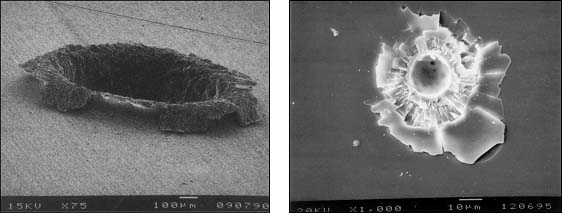An impact is generally called hypervelocity when the velocity of impact is such that the projectile and the target are completely destroyed in the area around the impact point. It generally occurs in the region where the velocity is higher than the sound velocity in the material and leads, in a solid surface, to a crater resulting from target melting and vapourisation.
Three processes could be involved, dependent on the projectile velocity: elastic, plastic and hydrodynamic. In the last case, target and projectile behave like fluids and crater parameters depend more on projectile and target densities and impact energy. Craters morphologies (shape) resulting from hypervelocity impacts depend largely on the target material and evidence of the impactor is often difficult to find.

Figure 3a. and 3b. Hypervelocity impacts on a ductile aluminium plate (left) and on a fragile material (right).
During an impact on a ductile target, elastic deformation is followed by a permanent plastic deformation in the neighborhood of the impact point. The generated crater is globally hemispherical and surrounded by a melted material lip. A lot of materials present this kind of behaviour; among them we find metals, alloys and some polymers. Ductile materials have a low hardness.
On a brittle target there is no plastic deformation but many fractures are generated. The material will melt at the center of impact but the lip is often ejected by the broken of the target behind the impact point. Fragments are generated close to free surfaces around the pit. Glass, steel, ceramics and concrete are fragile materials. They are strong with a high hardness.
In the case of multi-layers materials, a part of the shock wave is reflected and the other part is transmitted to the sub-levels.

